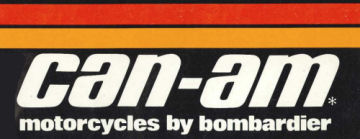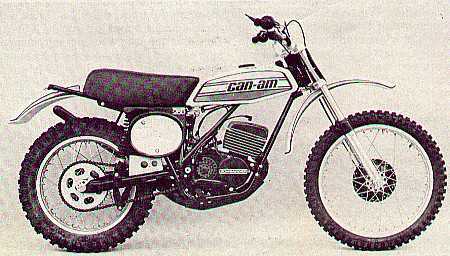


| The Myth of the GP 250 (Frame #5860) | ||||
Sometimes we remember things in life better than they
actually were. For instance, I haven't been able to ride for 12 years, but somehow remember myself
riding much faster than some of my friends recall. Take the time I passed 2 factory supported CanAm
riders on the last lap of the Virginia City Grand Prix in 1978.  That's the part I remember. But the part my friends
remember is that the 2 riders were John McCowen and his dog "Kookie." Personally, I think this is
splitting hairs, but others apparently find more significance in the minor details. Hence, goes the
legend of the 1975 GP 250. No single model CanAm has ever developed more myths, rumors and impaired
memories as this machine. There is probably more incorrect information about the GP 250 floating
around the "CanAm grapevine" than any other model ever made. I should know, I get at least one email
message mentioning the GP almost every day. That's the part I remember. But the part my friends
remember is that the 2 riders were John McCowen and his dog "Kookie." Personally, I think this is
splitting hairs, but others apparently find more significance in the minor details. Hence, goes the
legend of the 1975 GP 250. No single model CanAm has ever developed more myths, rumors and impaired
memories as this machine. There is probably more incorrect information about the GP 250 floating
around the "CanAm grapevine" than any other model ever made. I should know, I get at least one email
message mentioning the GP almost every day. The truth be known, I myself, have only seen one fully assembled "production" GP 250 in my life -- and that was 25 years ago. And at the time, I didn't really know what I was looking at. Since only about 250 of these machines were made, most of us have never seen one at all. In all honesty, I have passed on incorrect information to viewers because it came to me from reliable sources. Realizing this I've taken it upon myself to acquire some old magazine road tests and reinforce the integrity of the Classic CanAm website. In the process, I even found a genuine "Tony Murphy" article on the bike passed on to me by Rae Tyson (thanks Rae). First, lets take care of the myths:
|
||||
None of the old magazines I found were very kind to the GP 250. All of them raved about the incredible horsepower, but ALL of them felt the bike was difficult to ride and at best "a handful." These machines were not for the novice, but then again, they weren't intended for that market. The blast of power could not be transmitted to the ground with the crude suspension, and from the sound of it, would generate more trouble than speed. Even Tony Murphy (long time CanAm advocate) wrote that the bike required a great deal of expertise to ride. So why are these bikes so popular with CanAm collectors and
enthusiasts? First, finding an intact and restorable GP 250 is a feat in itself.
Figure that just over 200 were made, and most of those are now in a landfill
project somewhere. To a CanAm collector, owning one of these machines in pristine form would be a wet dream come true. But for vintage racing purposes (i.e., AHRMA events), the motorcycle would probably have to be raced in the post 74 "historic" class against bikes with much better suspension and handling. All the horsepower in the world is useless if it can't be transferred to the ground and only instills fear in the rider. Our Classic CanAm racing team realized this point quickly when we started vintage racing using an MX-1 250 with MX-2 porting and rotary valve. The power hit so hard our rider couldn't hook up with the limited 4" of rear suspension travel. And when he did get traction, most of his effort focused on getting the front wheel back on the ground while hoping that the bike stayed pointed in the right direction. Dropping in the milder TNT rotary valve might have cost us a couple HP on top but improved lap times immensely. If it sounds like I've bashed the legendary GP 250 it's unintentional. The intent of this short piece was to clear up some of the confusion about the bike. As I said earlier, I get a great deal of email generated by this website asking questions about various models and "how good" they really were. The GP 250 powerplant is about as close as one could get to a real "works" engine. Truly, it was nothing short of engineering artwork. But the chassis is nothing more than a pre-production MX-2 with a few extra holes drilled about to lighten it up. In fact the MX-2 chassis was probably much better because of the improved suspension. Should every true CanAm collector have a GP 250? Do buzzards have lips? Do Maico riders own wrenches? Does Bill Clinton believe in 1 Hour Martinizing? |
If you have a query or information about Can-Am motorcycles please contact us